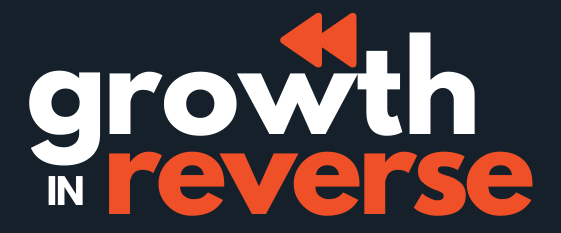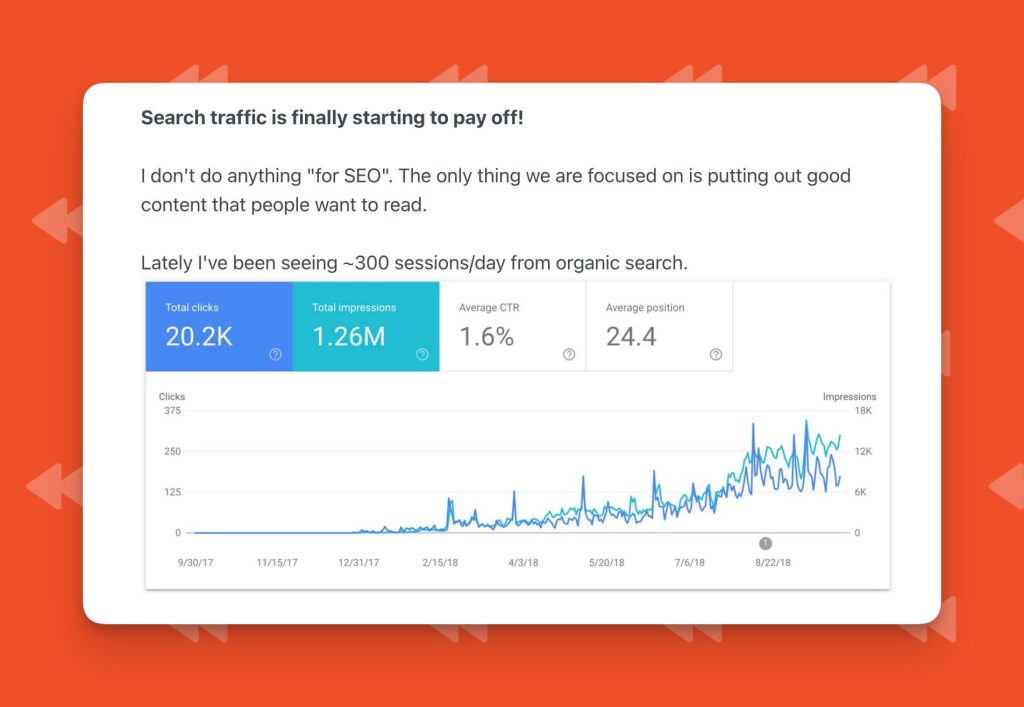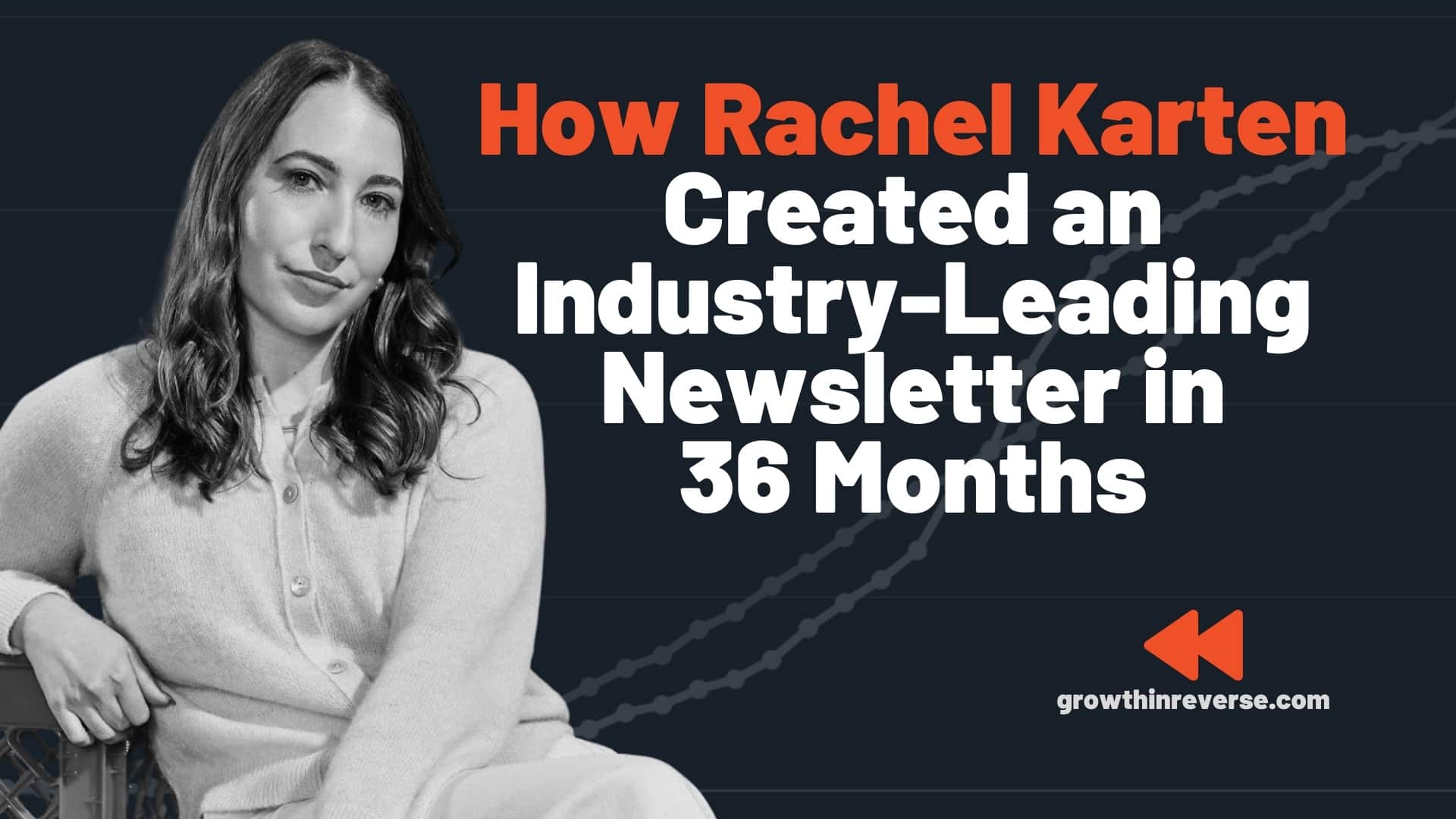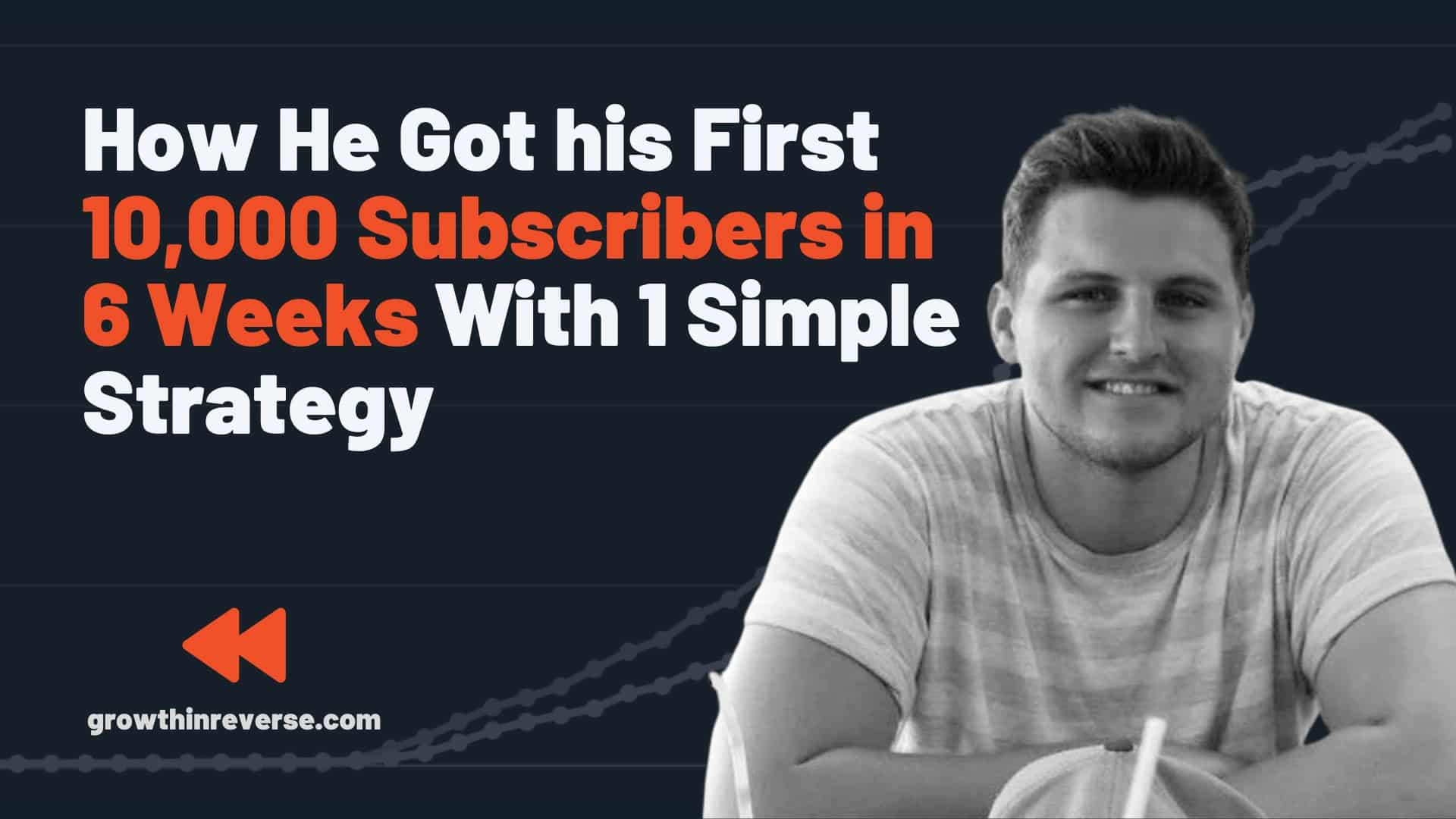Pat Walls launched Starter Story in late 2017 and has grown the site to a mind-boggling 1.6 million visitors per month, and over $1 million annually.
Starter Story is a content site that primarily has interviews with founders of successful businesses. These run the gamut of e-commerce, SaaS, newsletters, and more.
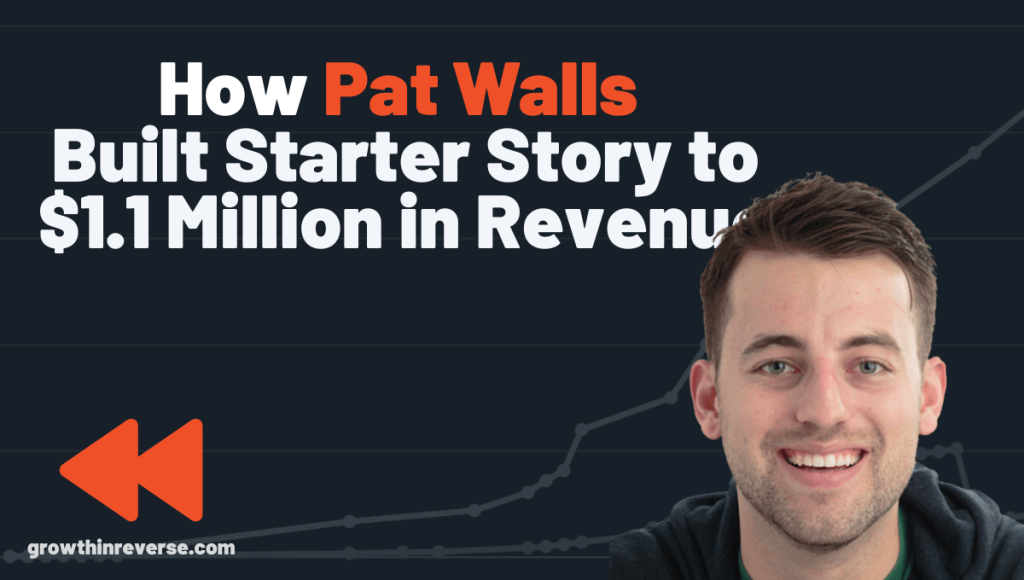
Each interview includes revenue numbers, profits, business costs, and the background of how they got started.
A lot of these businesses you might have never heard of, but they’re making tens of thousands or even hundreds of thousands of dollars per month.
So how does Pat and the Starter Story brand make money from publishing text-based interviews? Let’s take a look.
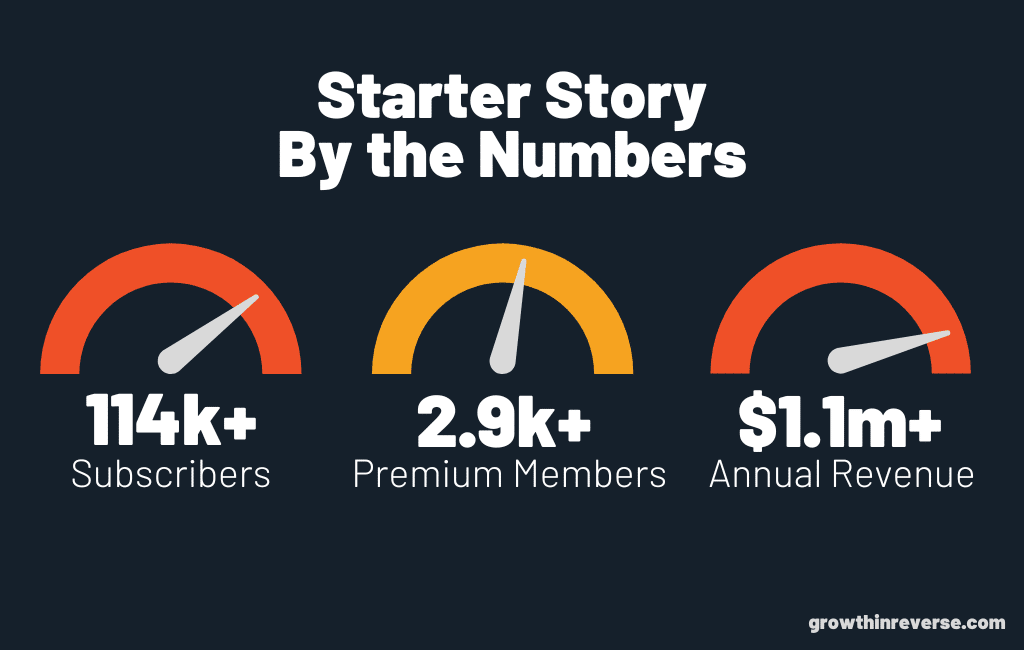
How Starter Story Makes Money
Starter Story brings in around $1.1 million per year in revenue.
Pat posted on Reddit in September of 2022 about how the business was bringing in around $79k each month.
I used that, along with some more recent premium member numbers that I found to back into some updated numbers, and estimate he’s now bringing in almost $100k per month.
There are 3 main ways that Starter Story makes money today.

1. Sponsorships & Ads
Sponsorships account for a slight majority of the revenue Starter Story brings in, around 57%.
In March of 2019, Pat said Klaviyo started paying $4k per month, or $48k per year to sponsor the whole website and newsletter. They booked out this sponsorship for a whole year.
Clearly, it was profitable as they sponsored it for years.
Eventually, he added more sponsors on top of the main Klaviyo one, making it kind of hard to back into the numbers and figure out what they’re paying now.
But, in total, sponsorships and ads are bringing in around $640k per year.
2. Subscriptions & Courses
Starter Story has a similar business model to what the New York Times has for its content.
You can read ~3 articles for free, but if you want more, then you have to buy a subscription.
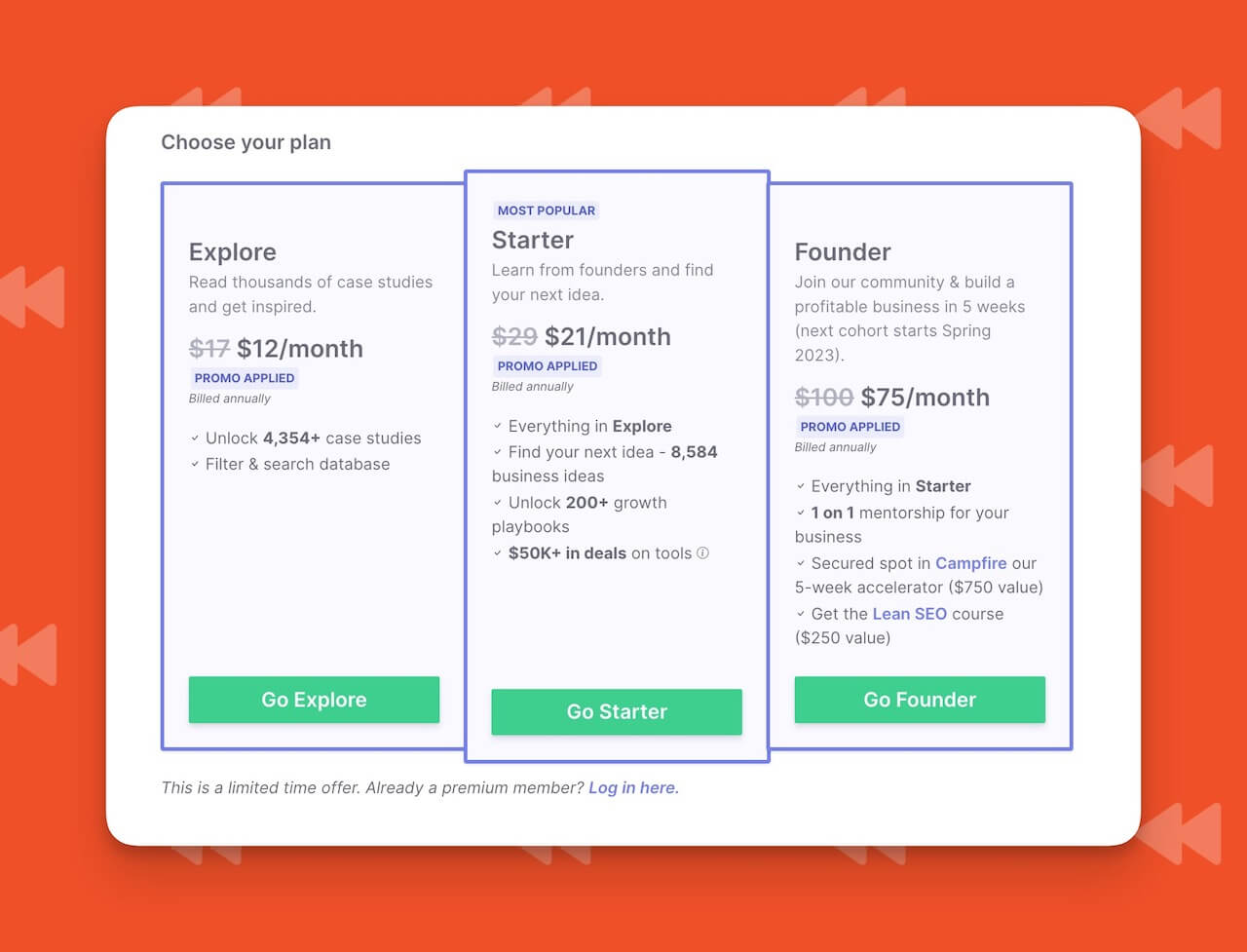
There are 3 pricing tiers for the subscription, with the highest one including their courses and mentorship for your business.
Pat also created the Lean SEO course that walks through how he grew the website to over 1M monthly visitors from search alone.
He sells that as a standalone product that can be bought without having an annual subscription. Right now it’s $249, but it looks like they’re increasing the price to $449 here soon.
Memberships and his SEO course make up around 38% of their revenue.
3. Affiliate Marketing
Throughout the site, there are links to tools that some of the founders being interviewed have used to grow their businesses. Many of these are affiliate links, and Starter Story gets paid a commission when these are used.
Affiliate marketing accounts for around 5% of revenue. While that sounds like nothing, that’s around $56k per year just from people clicking links on the site.
Starter Story’s Growth Timeline
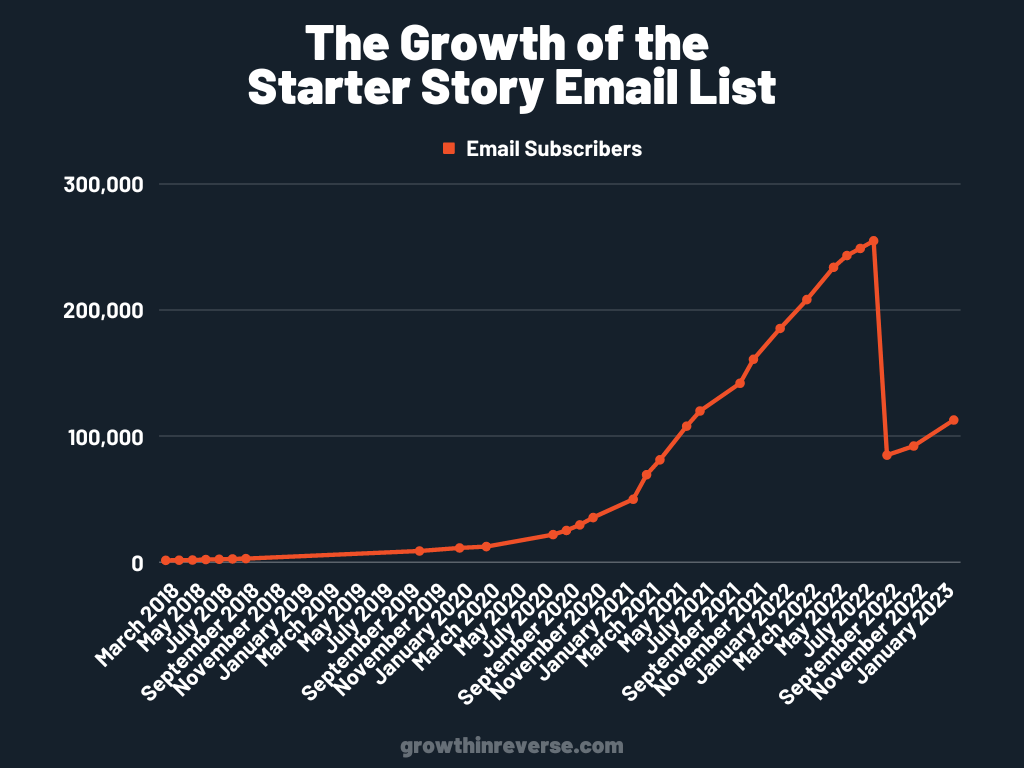
I know what you’re thinking. I must have done something wrong in my research.
No newsletter just takes a nose dive after that much growth unless they just stopped writing the whole thing.
I was so confused after seeing these numbers drop like that.
I’ve never done this with a deep dive and usually just collect all the data on my own, but I had to reach out to Pat and see what happened.
I message him on Thursday and just asked if they had chopped the list or what happened. We weren’t connected or anything so I was little nervous my message wouldn’t get seen.
Thankfully, he responded pretty quickly:

So I wasn’t going crazy – they did cut the list from 245k down to around 80k and it’s now back to 114k.
Now that you have that context, here is the full timeline. You can see that big drop on the right-hand side of the chart in 2022.

The Growth Levers Pat Used
There are 4 main growth levers that helped grow Starter Story to where it is today.
1. SEO and Content Creation. While it took him a few years to realize its potential, Pat started investing heavily into optimizing content for search engines. He now gets 1.6 million people to his site….every month.
2. Experimentation. Pat seems to always have some kind of A/B test or experiment running. I’ll share some of the more impactful ones he’s done.
3. Automation and Systems. Between building custom tools to save a few minutes here and there, to creating templates for similar types of content – Pat uses really smart automations to help him run a massive content business.
4. Building in Public. He’s been doing it since before it was even called Building in Public, but that’s exactly what he’s done. And it’s helped connect him with thought leaders and is almost a flywheel to get more founders for his interviews as well.
1. SEO & Content
I was going to separate these two, but it’s really hard to talk about content without SEO and vice versa.
Why separate them?
For the first few years, Pat was not focused on SEO at all. He even admitted that in one of his posts in late 2018:
Since that time, he’s seen the light, and now is bringing in over 1.6 million visitors to the website – a majority of which come from SEO.
But he approaches it pretty different from the typical SEO strategies you see online. Instead of just finding keywords he wants to rank for, he uses a framework he calls “Lean SEO.”
Here is the outline of his Lean SEO framework:
1. Research: Identify opportunities for content through quick research
2. Create: Create MVCs (Minimum Viable Content) to test if your site will even rank for this topic.
3. Test: Don’t touch it for 30 days, but keep an eye on the traffic and rankings for those pages.
4. Decision: Iterate on your content based on its performance
5. Scale: When one of those pieces of content works, scale it by optimizing the page and spending more time fleshing out that piece of content.
This framework gives you lots of “small bets” to find one that works instead of taking the time to build out the best piece of content and never have it rank well.
His keyword research method is different too and says he doesn’t do the traditional method of keyword research.
Instead of going to SEO tools and looking for keywords, he teaches people how to find good topics and formats to replicate, instead of focusing on a larger keyword they probably won’t rank for.
Once a page is ranking, you can see what it’s ranking for and back into the keywords that make the most sense to go after.
Pat created a course called Lean SEO that he built to teach others how to get the same traction he has with SEO.
New Content Formats
Once he realized SEO was a gold mine, he started seeing opportunities everywhere.
On top of putting out multiple interviews per day (yes, per day), he also started putting together other types of content:
- Business name ideas
- Business idea directory – business ideas database you can filter based on potential revenue and other factors
- How-to guides and articles
Some of the experiments I share in the next section also tie in with SEO because they improve the user experience and how long someone might stay on the website, which is a positive signal to Google.
The framework Starter Story used to grow to over 1M visitors/month.
Pat walks through the automations he's using, how he spends just a few hours creating content, and his methods for finding great ideas for content.
Experiments & A/B Testing
Pat is someone who experiments a lot with his website and newsletter. It seems like he has a running list of things to try out all the time.
Here are a few of the ones I found:
Adding a Static Table of Contents to the Sidebar
Pat experimented with adding a table of contents in the sidebar to help people navigate the pages more easily.
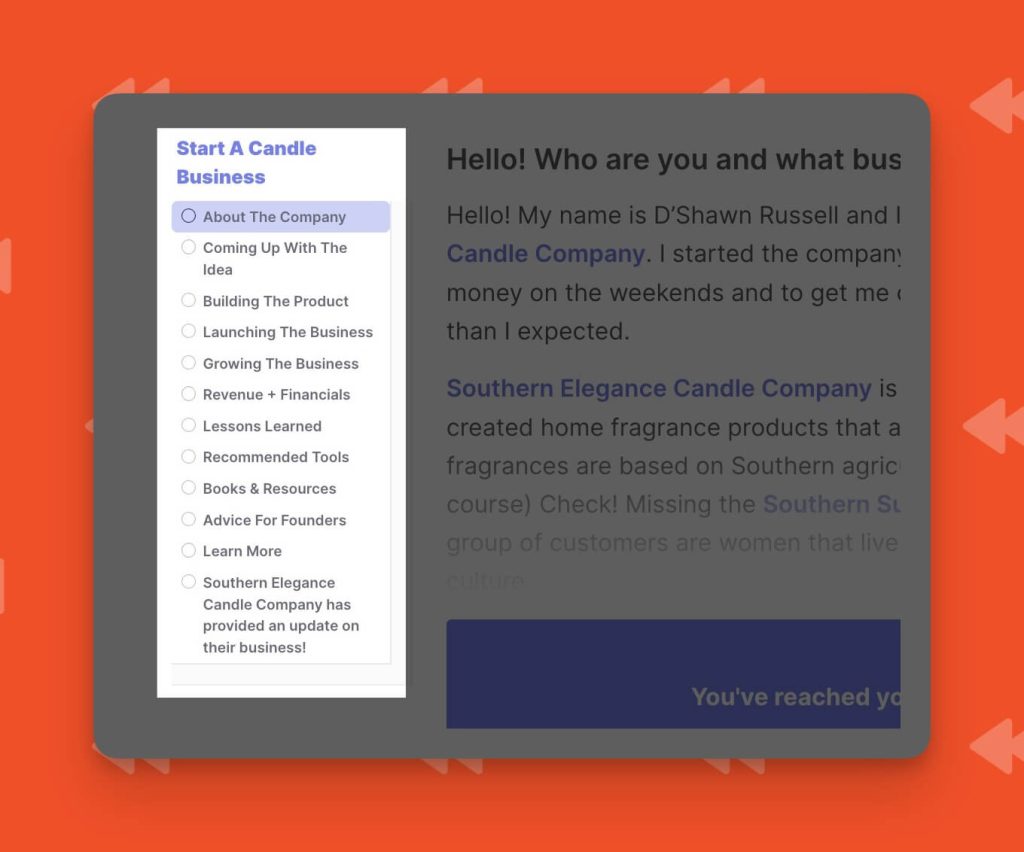
His theory was that this would increase “dwell time” on the site, which is a positive signal when it comes to SEO and Google rankings.
The results:
- Visitors spent 2x more time on the site
- People were visiting more pages
- People were more likely to signup for the email list
Add Content Upgrades to Get More Subscribers
Instead of just asking people to subscribe, Pat wanted to try adding a content upgrade, essentially offering a free digital product.
In this case, it was a document with 1,000 business ideas.


After running this test for a few weeks, he saw his conversion rate go from 1.95% to 2.53%, so he scrapped the test and went with the content upgrade since it was working well.
Testing a Different Format for the Newsletter
In July of 2020, they started running a new format of the newsletter. Before, it was shorter and didn’t have much commentary included.
But they started adding “more long-form and opinionated” content in the newsletter itself.
The results? Open rates went from 17% to 27% and click rates from 3% to 6%.
That’s almost double on both metrics. I’d say it was a good move!
Adding Popups to the Website
You can say what you want about popups – but they work.
This is so similar to what Harry Dry from Marketing Examples said. For a while, you’re thinking that popups are annoying and so you don’t use them.
But what if you implement them in a way that isn’t annoying?
That’s what these guys have done (myself included), to test it out and see what happened.
Creating a Wikipedia Type Content Structure
Pat even tested out content where his visitors could edit it and make changes, kind of like Wikipedia.

These pages no longer exist, but from seeing this quote you can tell that Pat is thinking BIG about Starter Story.
He wants it to be the place where entrepreneurs and startup founders go to get their information.
Publishing a Book
On August 30, 2019, Pat published the Starter Story Book on Amazon. This seems like it was kind of out of nowhere, and aside from this launch post, he didn’t really bring it up before that.
I had to include at least a few failed experiments! 🙂
2. Systems & Automation
Pat has been using automation to run the business more effectively since the beginning.
He has a background as an Indie Hacker and builder, so these automations almost seemed to have started as fun side projects.
As a solo founder, I believe it’s important to automate as much as you can. Freeing up your time is crucial to getting more done.
PatWalls.com
Things Pat Has Automated
Side note: Some of the things he’s been able to automate might be a little challenging for someone without the background of a developer. But with all of the no-code tools and resources we have, this is still super relevant to learn from.
This is not everything he’s automated, but I included quite a few to give you some creative ideas for automating parts of your own process.
Creating Images for Social Media
For each new post, Pat wanted to include an image that was shown when people shared the article on social media.
These images are a combination of:
- A photo that represents the business covered in that interview
- The title of the post
- The interviewee’s headshot
- The Starter Story logo.

While each one only took him around 10 minutes, when you’re creating lots of content every day, 10 minutes each time adds up fast.
You can use tools like Banner Bear or Placid to help with this.
Automatically Create an Audio Version of Each Interview
In 2020, Pat used a tool that would automatically turn each interview into a podcast-like audio file.
That tool was called Blogcast, but I’m not sure he’s still using this today. The example on their website was a little, fake-sounding.
But, the concept is something that people like Packy McCormick and Mario Gabriele have implemented too. Not everyone wants to spend the time reading thousands of words, but giving them other options for consuming your content can increase your following.
Automating Some of the Writing
More recently in 2023, Pat added GPT3 capabilities to help his team write intros and conclusion paragraphs more effectively.
You can see it in action here:
Posting to Social Media
Pat used the Buffer API to queue up his new posts based on a schedule he’s set up for posting on both Instagram and Twitter.
While you can use the native Buffer scheduling app, he used his development skills and took it a step further. Every post is auto-scheduled based on where it is in the workflow within his database.
Automating Reddit Posts
Yes, I said above he automated social media, but this Reddit system he built out is next level.
Pat was getting really good results from Reddit, but crossposting to the site was becoming a big time-suck. And he was spending a lot of time scrolling Reddit, which added to the time wasting.
So, he automated it.
- He collects each founder’s Reddit username with the interview (so he can tag them)
- He writes all the stories in markdown format which is what Reddit uses too
- Automatically includes an intro that dynamically pulls in the person/companies name and the URL to the new interview
- Reddit doesn’t like certain links, affiliate links, or link shorteners (think bit.ly) so his platform will automatically remove them.
- His automation posts to 4 different subreddits, each on a 15-minute interval between so he doesn’t get marked as spam.
This is just genius. He probably saves at least 30 minutes each time by building out this system. As with everything else, he said he slowly built it up over time.
Here is the full story on Hackernoon.
Staying on Top of Social Mentions
Pat set up a tool called Mailbrew to alert him of new mentions on Twitter and other social platforms.
After reading this, I set up my own alerts. While I’m not getting a ton of mentions yet, it helped me find this recent one:

You can essentially create a custom daily email that includes your mentions on social, updates from websites, RSS feeds, and even a daily schedule from your calendar.
Pretty cool!
Automate Emails
Pat goes through a lot of emails each day.
Since all of his interviews are text-based, email is how he reaches out to potential guests, sends the interviews, gets the interview back, and follow up if he needs clarification or hasn’t heard from someone in a while.
He even custom-coded his own CRM that lives inside of Gmail called Pigeon (which he’s since sold to focus on Starter Story).
- Automates the follow-up process if he hasn’t heard back
- Keeps track of each project based on where in the conversation they are
- Keeps him from forgetting about a specific interview
This is brilliant, and I’d love to find a way to incorporate some of this into my process.
His Process for Creating Automations
Pat has a process for figuring out how to automate things.
He starts by thinking about the tasks he’s spending time on. And then he’ll start slowly automating pieces of them.
In an interview with Steph Smith, Pat said:
“When I think about automation, I don’t think about how I go from zero to full automation. I’m like OK, there’s one step which is writing the description of the Instagram post.
I don’t want to write the description every time, so I’ll build some code to generate it from the article content itself.
Then, when I go to post on Instagram I’ve shaved off maybe like a minute or two of extra time that it would take me.“
And he iterates on it from there.
- Start with a small piece of the bigger process
- Once that’s working, add more to it.
- Always keep an eye out for things that could be automated.
“Before you know it, you have all these little mini-automations.”
4. Building in Public
Pat has been building Starter Story in public since the beginning. But it wasn’t always called “Building in Public” like it is now.
Being open and honest about what he’s sharing has made a big impact. Not only has he been able to meet some of his digital idols like Pieter Levels, but he’s been able to get feedback from customers, and get ideas on how to improve the site.
You can see a long list of posts he has written about growing Starter Story here. He also has a fantastic blog at PatWalls.com where he shares numbers, revenue, tests he’s tried and just life updates.
I personally found that sharing my metrics and being transparent was just a really fun way to meet people online, share your story, and help others out.
Pat Walls
Building & Selling Courses in Public
One of the coolest examples of how building in public has helped him, has to be when he created the Lean SEO course.
Building in public has helped Pat sell his Lean SEO course, and more recently his upcoming Lean Email course.
He posted this tweet in November of 2020:
In the blog post, he asks people to message him if they might be interested in a course like that.
And then this happened:
After that, he tweeted every few hours with updates about the course.
- I started outlining the course
- Here’s what it’s going to include
- He emailed everyone back personally and asked what would be helpful
By December 2nd, he had his $10,000 in preorders for the Lean SEO course.
He launched it in early December and these were the results:
He only had around 10,000 Twitter followers at the time, so it wasn’t like he had a massive audience. But they were an engaged audience.
Since this time, he has more recently launched a course called “Lean Email” in the same manner. I was one of the preorders.
It launches in March and I can’t wait to get my hands on it.
Sharing His Wins & Getting Featured
Another benefit of sharing in public is that people want to help and share your stuff.
In January, Pat posted that he was seeing crazy growth in terms of his email list, and that it was bringing in almost 1000 people a day.

And then in the comments people were asking how he did it, and he said it was a mix of AB tests and other things.
People wanted him to write a longer post, but it seems like Alex Garcia from Marketing Examined might have taken the lead on this.
On February 15th, Alex posted a really good breakdown of how he did this, with visuals and data that seem to have come from Pat.

It’s a 12-page document post on LinkedIn, and I couldn’t embed it here, but go check it out.
But Alex has over 160k followers on Twitter and over 55k email subscribers, so this was great exposure for him too.
Building in public allows Pat to go back and show that he put in the work.
How You Can Replicate Pat’s Success
While Pat’s been doing this for 5 years, there are a lot of things you can use to replicate some of his successes.
SEO and Content
Don’t write this one off. Pat might be even further along if he had started from day one.
While not everyone can put together multiple pieces of content per day, you can still have success following some of Pat’s strategies.
For SEO, follow his Lean SEO framework, and implement the basics:
- Improve your page speed (reduce image sizes, implement Cloudflare, etc.)
- Try and keep people on the page longer (improve dwell time)
- Answer their questions fully so they aren’t going back to search again
- Use titles that include numbers and clickable words so they stand out
The framework Starter Story used to grow to over 1M visitors/month.
Pat walks through the automations he's using, how he spends just a few hours creating content, and his methods for finding great ideas for content.
Experiments and Testing
If you have an idea that something might work better, test it.
Some ideas for tests you can start with
- Different copy on your email optin forms
- Test different offers (content upgrades) people get when signing up
- Test removing everything but the email form and heading on your signup page
- Add an email form to your sidebar
- Try different formats within your email
- You can test email subject lines to see what gets a better open rate
- Test your Twitter profile description with a tool like this
The world is your oyster (yea I said it) when it comes to this stuff.
Just make sure you’re giving these tests time to run and get real statistically significant results. Here’s a calculator you can use to make sure.
Try Adding Automations
I know Pat has built some extensive automations. While not all of us will be able to recreate them to the level he’s done, we can still use no-code tools to improve our processes and save time.
For example, I use a tool called Process Street to make sure I go through all of the steps necessary to get these deep dives out on time.
There are all kinds of tools you can get started with. Zapier or Make.com are great places to see what’s possible.
As Pat says:
- Start small
- Automate one step at a time
- Once you’ve got that process down, add more.
Building in Public
Sharing your wins and losses can have huge impacts on your growth and speed things up as well. While you don’t need to share everything, the more vulnerable you are with what’s going on, the better.
Some of the interviews I listened to with Pat, the interviewer started off by saying “Wow, I love reading your blog, it’s helped me throughout the years.”
There are a few benefits to building in public:
- You have access to people you otherwise wouldn’t
- You can get featured on websites and invited on podcasts
- Get feedback that can help you grow faster
- You can build a full-blown course in public (or two!)
As with everything, start small, and grow over time.
